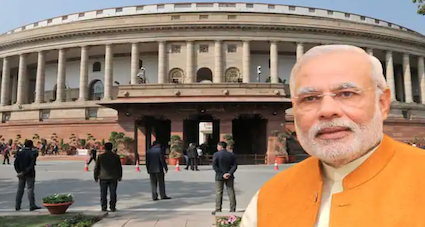We have this noise by the Opposition that the NDA government, since 2014 to present times, has sent less Bills to parliamentary standing committees than the previous UPA governments (2004-2014) and it marks an alarming decline in Parliament’s functioning.
It’s pointed out that between 2004-2009, UPA sent 60% Bills to the parliamentary committees and it jumped to a whopping 71% between 2009-2014. In contrast, it is alleged that NDA sent just 27% of Bills to parliamentary committees between 2014-2019 and since then, in its second term, a mere 12% Bills have been referred.
On closer inspection, as per PRS Legislative Research Data, between 2014-19, 18 Bills were introduced in Rajya Sabha and 61% (11 bills) of it were referred to Standing Committees. In Lok Sabha, the percentage was 28% since five Bills were referred to the Standing Committees.
Apparently, the data used by the critics of Modi government is selectively used. For instance, In UPA I (2004-2009), only 48% of bills were introduced to Standing Committees in Rajya Sabha. The percentage drops to 30% in Lok Sabha. And that’s because the numbers of Bills introduced were more than a hundred! That a majority of them lapsed tell its own story.
Same was the case in UPA II (2009-2014). Only 51% of the Bills were referred under the Rajya Sabha—and 27% under Lok Sabha.
Referring the Bills to Standing Committees is no barometer to Parliament’s functioning. For one, the Parliamentary Standing Committees were constituted in 1993 only. If this alone is the measuring yardstick, does it imply that Nehru, Indira and Rajiv Gandhi sabotaged India’s democracy? By this token, the Constitution, made by BR Ambedkar, was also not sent to the standing committee!
Further, not all Bills are sent to the Standing Committees, e.g, Ordinance replacing Bills, Money Bills, important Constitutional Bills (e.g. revocation of Special Status to J and K under Article 370).
The truth is, these committees on their own don’t approve the bills. That’s done by Parliament and Parliament alone. These committees are only subset of Houses.
It’s also undeniable that a government without a majority of its own (such as UPA I and II) need the crutches of standing committees since it’s made of coalitions and several other parties could’ve different point of views. A majority government, such as NDA I and II, on the other hand, are not a stitched coalition and could carry the floor on its own.
Another charge against the Modi government is that it doesn’t indulge in debates in the Parliament.
The truth is NDA government has spent more time on debates in Parliament than UPA. For instances, during the 16th Lok Sabha (2014-2019), 32% of the bills were discussed for more than three hours—much more than what UPA could manage on its two terms—22% and 14%.
Interestingly, there was no noise when in the 15th Lok Sabha (2009-2014), 36% of the Bills passed were debated for less than 30 minutes. Indeed it took only five minutes to pass 20 Bills!
In contrast, the debate on the 122nd Amendment of the Constitution—GST BIll—in 2014 took almost 12 hours, spread over two sessions!
The productivity record of two governments—UPA and NDA—is not even in the same league. For example, under NDA, the 16th Lok Sabha (2014-2019), it stood at 84% as compared to outgoing UPA II (2009-2014) of 61%. In its present term, NDA has had an astounding productivity data of 135% in Lok Sabha and 100% in Rajya Sabha.
Indeed, the 15th Lok Sabha(2009-2014) was the least productive in 10 years. No less than 68 Bills were found to have lapsed after its dissolution.
Rahul Gandhi, who’s often seen putting blame on the Modi government for not allowing them to speak, has just 52 percent attendance and took part in 14 debates and as for questions, didn’t ask any!
Would you find all these facts in your tomorrow’s daily? Fat chance.


